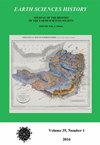地质过程对智利中南部马普切土著人宇宙观的影响
IF 0.6
4区 哲学
Q4 GEOSCIENCES, MULTIDISCIPLINARY
引用次数: 0
摘要
我们对自然地质和气象事件如何影响智利中南部马普切人的宇宙观进行了解释。这些事件是南美洲活动大陆边缘发生的地球动力学条件和相关过程以及该地区的气候条件造成的。他们对马普切人宇宙观的影响清楚地反映在马普切获得知识的最重要的神话传说中。一个特别能说明问题的神话是两条巨大的蛇Trentrén和Kaikai之间的战斗。代表海洋的Kaikai不断试图侵占地球,代表地球的Trenten通过抬高地面拯救居民来反对Kaikai。这被解释为地震期间发生的事情的寓言,当海啸波的来回运动使其看起来像是地球下沉和上升。几个名为Trentrén的山丘是人们可以攀登的地形高度,以避免海啸的影响。其他神话传说是指在这种特别活跃的构造环境中的其他特征性地质现象。本文阐述了对地质事件的神话解读如何构成对周围世界的理解,并在马普切文化中产生了精美的神话传说。本文章由计算机程序翻译,如有差异,请以英文原文为准。
INFLUENCE OF GEOLOGICAL PROCESSES IN THE COSMOVISION OF THE MAPUCHE NATIVE PEOPLE IN SOUTH CENTRAL CHILE
We present an interpretation of how natural geological and meteorological events influenced the cosmovision of the Mapuche people from south-central Chile. These events resulted from the geodynamic conditions and related processes occurring along the South American active continental margin and the climatic conditions in the region. Their influence on the Mapuche cosmovision is clearly reflected in the most important myths and legends of the Mapuche acquired knowledge. One particularly illustrative myth refers to the combat between two huge snakes, Trentrén and Kaikai. Kaikai, representing the ocean, continuously tries to encroach upon the earth, and Trenten, representing the earth, opposes Kaikai by uplifting the ground to save the inhabitants. This is interpreted as an allegory for what happens during earthquakes when the back-and-forth movement of tsunami waves makes it appear as if the earth sinks and uplifts. Several hills named Trentrén are topographic heights that people can climb to be safe from the effects of the tsunamis. Other myths and legends refer to other characteristic geological phenomena in this particularly active tectonic environment. This article illustrates how the mythical interpretation of geological events configured the understanding of the surrounding world and produced the exquisite body of myths and legends in the Mapuche culture.
求助全文
通过发布文献求助,成功后即可免费获取论文全文。
去求助
来源期刊

Earth Sciences History
GEOSCIENCES, MULTIDISCIPLINARY-HISTORY & PHILOSOPHY OF SCIENCE
CiteScore
1.00
自引率
0.00%
发文量
1
审稿时长
>12 weeks
期刊介绍:
Earth Sciences History promotes and publishes historical work on all areas of the earth sciences – including geology, geography, geophysics, oceanography, paleontology, meteorology, and climatology.
The journal honors and encourages a variety of approaches to historical study: biography, history of ideas, social history, and histories of institutions, organizations, and techniques.
Articles are peer reviewed.
 求助内容:
求助内容: 应助结果提醒方式:
应助结果提醒方式:


